The Surface 3 Review
by Brett Howse on May 4, 2015 9:00 AM ESTSystem Performance
Since the Surface 3 is a tablet that can replace your laptop, comparisons will be made between both devices. Because the new tablet is running full Windows 8.1 x64, it is possible to run the full benchmark suite that we have for laptops. On the tablet side, there are not a lot of cross-platform benchmarks so the only thing that can really be used is browser based tests. It is not ideal, but we have to work with what we have.
To summarize the Surface 3, it is powered by the top model of the latest Intel Atom 14nm stack. The Atom x7-Z8700 is a quad-core processor with a base frequency of 1.6 GHz. The CPU can turbo up to a maximum of 2.4 GHz, and all of this is done within a 2 watt Scenario Design Power. The review unit that I received is the $499 unit, so it only has 2 GB of LPDDR3 memory rather than the 4 GB offered on the higher priced model.
For comparisons against tablets, I have selected a sampling of several devices that have already been reviewed. Some of the devices are running on ARM processors, and several of the Windows ones run on Intel Core M, with a few more running on previous Atom architectures. To compare this device against any other device we have tested, please check out our Mobile Bench.
Tablet Performance
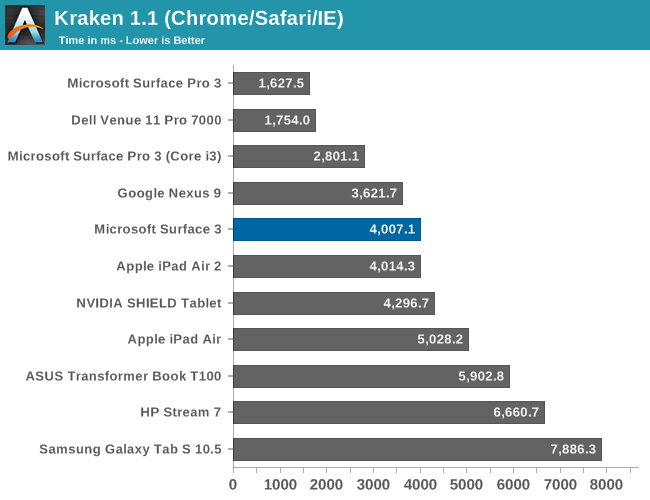
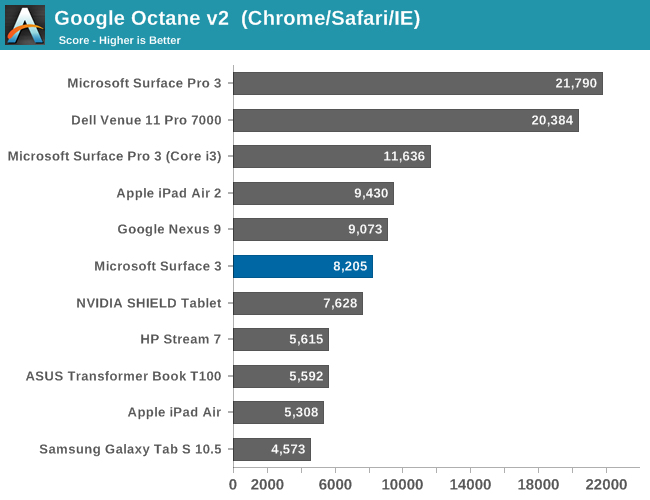

Since we just have web benchmarks to compare against other platforms, it does make it difficult to get a true feel for how Atom compares to the best, but when comparing to ARM processors it is fairly competitive. All of the web benchmarks are done using Chrome (hopefully we can switch to Microsoft Edge soon) because IE 11 has pretty awful javascript performance. Atom is a long ways off of the Core series in the Surface Pro line, and well back of the Core M powered Dell Venue 11 Pro tablet. There is a big jump in performance compared to the Bay Trail ASUS T100 and HP Stream 7. That is important since Cherry Trail is not a big architecture update, but mostly a process shrink, so the 14 nm processes can keep everything running at higher frequencies in the same power envelope.
Laptop Performance
By attaching the keyboard, the Surface 3 becomes a pretty reasonable laptop, so to see how much of a performance drop off there is with tablet class parts, the Surface 3 was run through our Laptop suite as well. The Atom is also equipped with eMMC storage, and some of the tests like PCMark take storage into account. Other benchmarks like Cinebench and x264 are CPU only. To compare the Surface 3 against any other laptop we have tested, please use our Laptop Bench.
PCMark

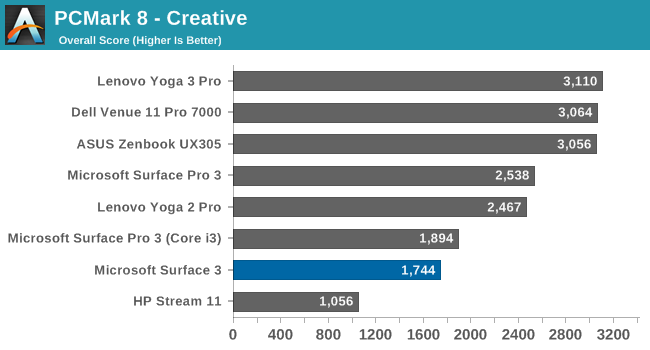
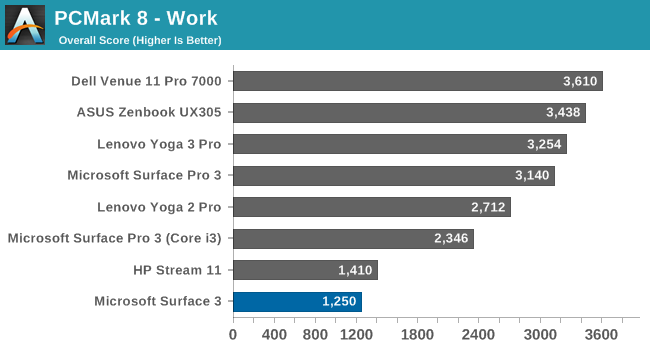
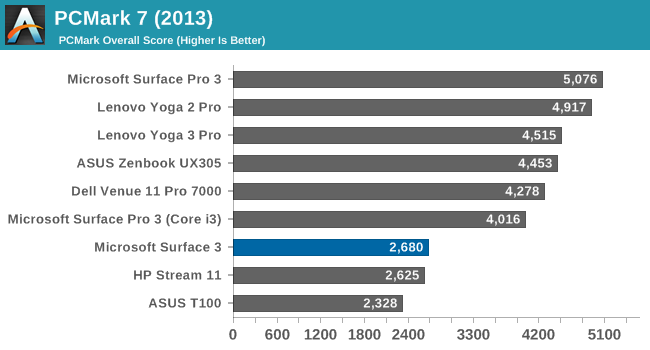
PCMark 8 from Futuremark has several benchmarks within it, all with the goal of simulating real-world use cases for each of the scenarios. It includes Home, Creative, Work, and Storage benchmarks. The workloads generally include both burst and sustained performance. The Atom can’t compete with the bigger Core pieces, but it is actually surprisingly close to the Core i3 Surface Pro 3. I think this is less about Atom and more about how handicapped Core i3 is with its lack of Turbo.
TouchXPRT


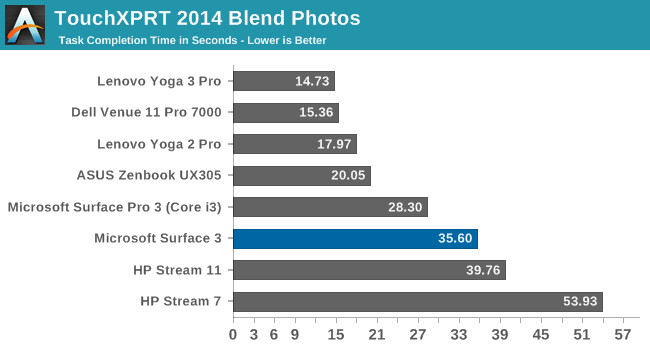
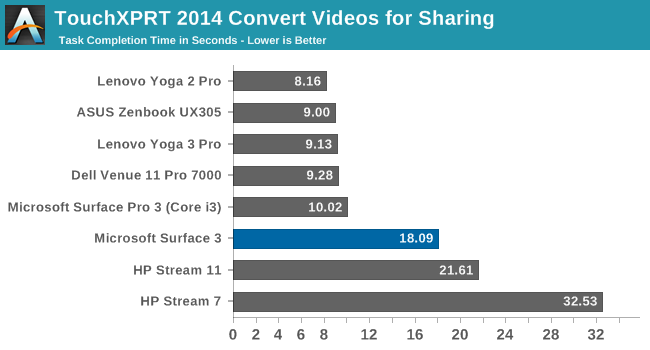
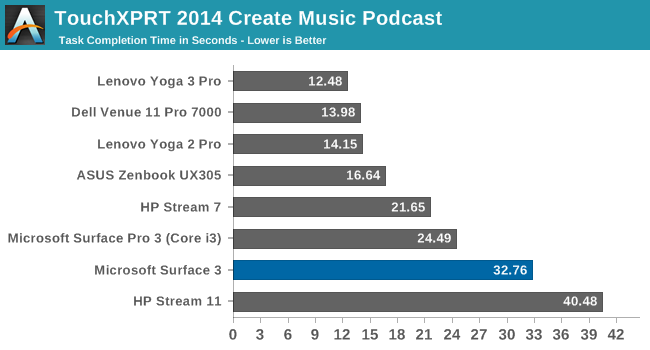
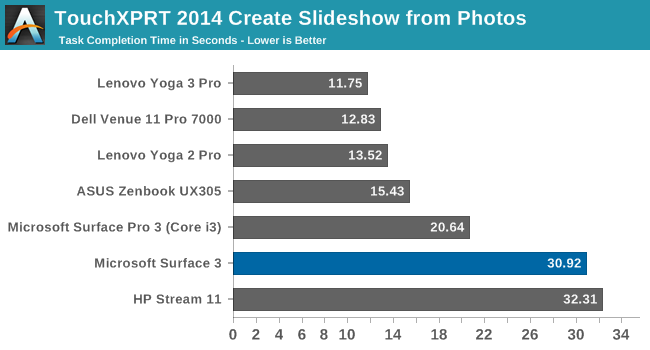
TouchXPRT 2014 is a benchmark that has a lot of burst workloads. The tasks are quick, but heavy, and it gives the processor a quick chance to cool off between each one so normally it is good about not running into throttling behaviour. The Atom processor is a long way off of the Core series here, with the exception of the i3 Surface Pro 3 which has no turbo capability. However there is a good bump in performance over the previous generation Atom in the HP Stream 7.
Cinebench

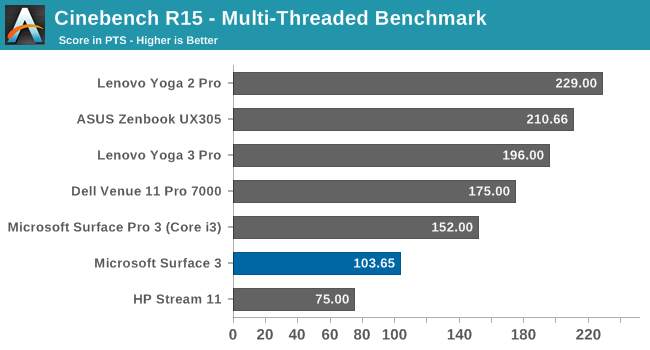
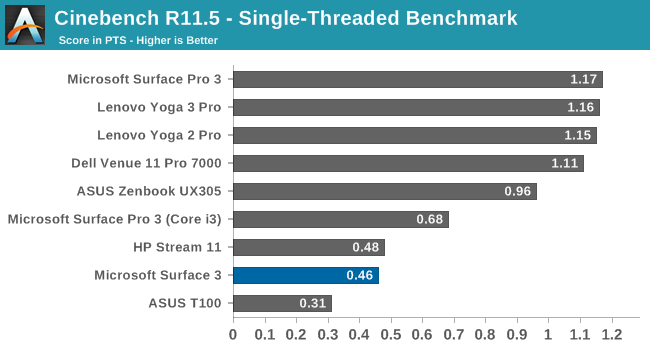
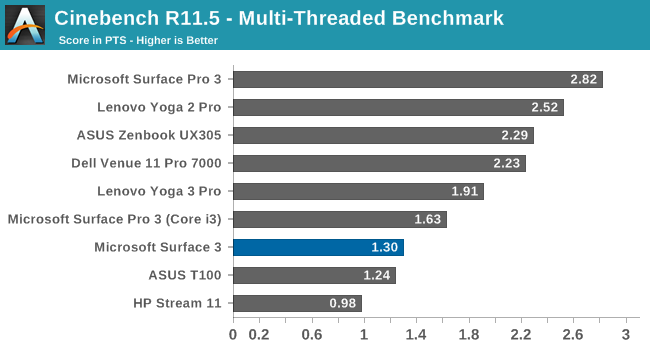
Cinebench is purely a CPU task, and it loves Instructions Per Clock (IPC) and frequency. There are two modes here with a single CPU run and all core run. It is still a long ways back of the Core i3 Surface Pro 3 on this test, and despite the Atom processor having four physical cores and the Core processors having only two physical and four logical cores, it is still not enough on the multithreaded run to really close the gap, although it does slightly. Looking at version 11.5 of this test, we have more data going back to older devices, so there are scores available from the ASUS T100 and there is a bump in performance compared to Bay Trail.
x264
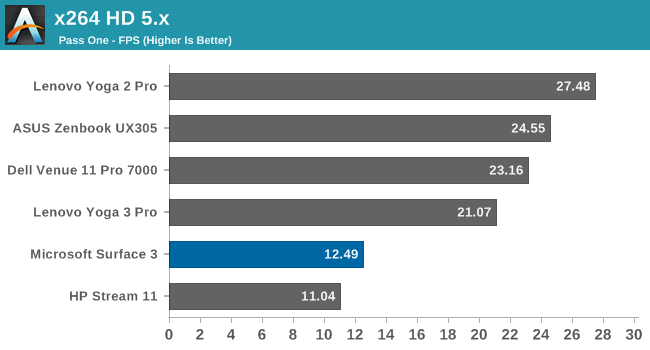

Once again this is a benchmark that prioritizes good IPC and frequency, along with multiple cores. The Atom struggles here compared to Core, which at this point should not be a surprise.
So clearly the new Cherry Trail CPU cores are not a giant leap in performance over Bay Trail, but like Haswell to Broadwell, there is a decent bump and the better manufacturing process helps increase overall performance due to the additional thermal headroom in the same power envelope. However when comparing it to the ARM competition, we only have a few data points but it does seem to be about on par with the top ARM CPUs at this time. Comparing devices across different operating systems is always difficult though.
Using the device day to day as a tablet though, performance was good. Yes, it could be better, and devices that use Core M are going to be able to run circles around Atom, but at the cost of additional heat. One of the nicest surprises of using this tablet was that it just never got warm at all, and the same cannot be said of any of the passively cooled Core M devices. Sure, when running very heavy benchmark loads, there was a bit of heat on the back, but it was never much more than around 30°C or so.
My experience was that when the Surface 3 felt slow, it was often not CPU bound but disk bound.










265 Comments
View All Comments
SpartanJet - Monday, May 4, 2015 - link
I initially wasn't going to buy but if you purchase through the Microsoft store you can get a 10% .edu discount and also use the 5% Microsoft discount you get by texting. My total came out to be ~$675 which included the 4/128, Type cover, pen, and tax.RBFL - Monday, May 4, 2015 - link
Did you look at the Thinkpad 10, when Lenovo has one its sales you can get the 4/128 with a 'real' keyboard for about $550. Admittedly one gen behind this on atom but not bad and seems to aim at quite a similar usage.RafaelHerschel - Tuesday, May 5, 2015 - link
I use MS Office plus iTunes and Kindle on a cheap Windows tablet from Acer with 2GB ram plus a 32GB ssd and everything runs just fine. I specifically wanted a 2GB tablet for testing purposes and I'm impressed how well it works.jabber - Tuesday, May 5, 2015 - link
I think some folks haven't realised that you DON'T have to carry around all your software and data ALL the time. Some of us work pretty light. My work laptop has hardly any user data on it at all. It all goes up the cloud. Software wise it has Office 2013, Firefox/Chrome and a couple of other bits and bobs and that's it. All sits on around 25GB on a 120GB SSD. Folks are weighing themselves down far too much. Take a serious look at what you really need/use.RafaelHerschel - Tuesday, May 5, 2015 - link
True. I had to make the transition as well. I used to fill up hard drives with clutter. I changed my attitude for a variety of reasons. One of those reasons is that wanted to work more efficient.On my desktop games take up space, but games can be removed and later re-installed from Steam or another similar service.
Michael Bay - Wednesday, May 6, 2015 - link
Have you ever used at least a baytrail tablet before spewing such nonsense?hans_ober - Monday, May 4, 2015 - link
The charge times are horrible. They should have added the Surface charging port + micro usb charge support (for emergencies). Or just used USB C.Doroga - Monday, May 4, 2015 - link
Would be a great thing to fix barrel distortion in product photos.Very easy to do it in full auto with modern software
duploxxx - Monday, May 4, 2015 - link
The GPU in the Surface 3 is really not enough to play most games, and even on our value settings, the Surface 3 is not a great experience for DOTA 2. The higher TDP of Core M lets it do ok in this test, but overall the Surface 3 is a long way back of even the Surface Pro 3 Core i3.poor Intel, 2015 and still not able to provide a gpu decent to play a game, guess what Intel look at the market, all kids use tablets these days to play games, none will ask for a x86 based one...unless they have stupid parents still just going for the jingle. but then again the market of mobile games is flood by ARM based games, way to late for mobile windows based things..
Jon Tseng - Tuesday, May 5, 2015 - link
Bay Trail runs Skyrim and Far Cry 3 fine. Cherry Trail with 4x the EUs should have no problem.I guess it comes down to your definition of "most games"...